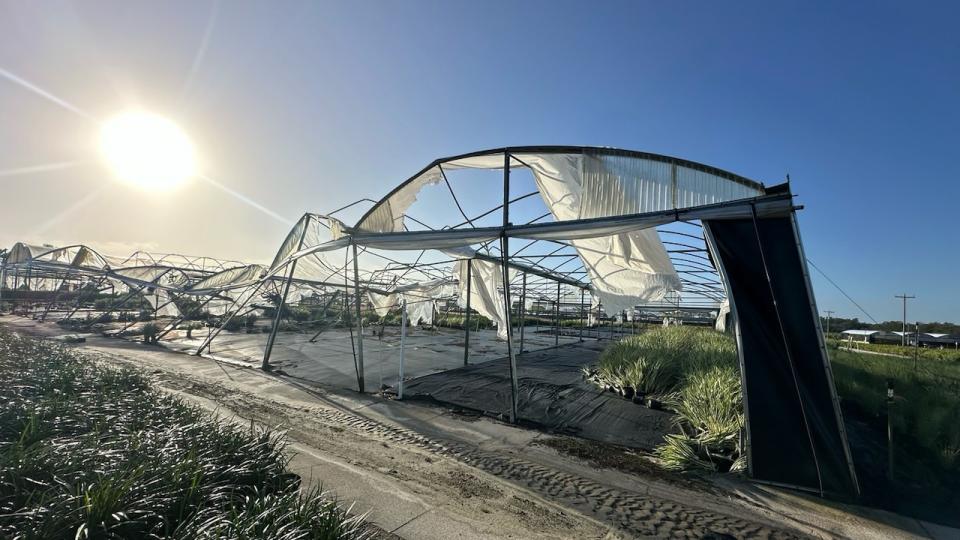The 2024 Atlantic hurricane season has officially established itself as one to remember. Since early August, Florida has experienced three landfalling hurricanes (Debby, Helene, and Milton). Each has upped the ante for those in the path. Understandably, Florida’s nursery, greenhouse, and landscape industries are feeling impacts. In the wake of Hurricane Milton, early reports indicate thousands of acres of plants have been destroyed, including entire crops of poinsettias ahead of the holiday season. See the slideshow below for multiple images captured after the storm.
Growers Speak Out
Several growers were gracious enough to share their stories as they dig out from Milton.
Mike Atchinson, Co-Owner of Atchinson Exotics, Delray Beach, FL: “It all began with Hurricane Debby, which flooded the nursery and left standing water that hasn’t subsided since. Heavy rains followed, and then Hurricane Helene hit, knocking down crops and causing more flooding. Milton was next, taking out century-old oak trees and damaging irrigation systems. Though not as devastating as Hurricane Ian in 2022, it was still a major setback. After four years of relentless challenges, it’s a do-or-die moment for the nursery and landscape industry now.”
Brad Bethurem, President of Brad’s Bedding Plants, Ft. Pierce, FL: “The storm hit with hurricane-force winds, stripping the plastic from the greenhouses before completely toppling them over. We had just finished renovations, and in a matter of minutes, everything was leveled. These greenhouses have weathered many hurricanes, but I’ve never seen anything like this — it’s surreal. It feels like starting from the ground up all over again.”
John Taylor, Manager of Ralph Taylor’s Nurseries, Bradenton, FL: “With tourism and agriculture as Florida’s two largest economic drivers, and tourism deeply dependent on the beauty of the landscape, the state’s economic recovery will heavily rely on the strength of its nursery and landscape industry.”
Jaynel Taylor, Nursery Operations Manager at Ralph Taylor’s Nurseries, Bradenton, FL: “Many of us will be looking to put the pieces of our homes and businesses back together. This is an opportunity for the nursery and landscape industry. Find a Florida Nursery, Growers, and Landscape Association (FNGLA) certified professional who can help you choose the right plants and the proper design practices for water sequestration and wind mitigation. Be ready for the next big storm.”
Strength in Numbers
In the wake of Milton, FNGLA has worked hand in hand with its chapter leadership to mobilize recovery efforts. “The devastation from Hurricane Milton not only affects nurseries and growers throughout the state but also the broader community,” says Tal Coley, FNGLA CEO. “Our industry is a key driver in Florida’s economy with a $31 billion total economic impact. And it’s the nation’s No. 1 producer of indoor houseplants and tropical foliage. By investing in recovery for our industry, elected officials will ensure a prosperous and vibrant future for Florida’s nurseries. Together, we have the power to overcome this setback.”
Where To Get Help After the Storm
A vital part of the disaster recovery process involves tapping into the sources available to growers.
USDA provides key steps to help with recovery. Here are some important factors and sources to consider.
Documenting Loss
Document damages and losses your operation has sustained as best you can, including gathering farm records, receipts, and pictures of damages or losses.
Reporting Loss
Once you are able to safely evaluate the impact on your operation, contact your local USDA Farm Service Agency (FSA) county office or your crop insurance agent to report all crop and farm infrastructure damages and losses. For producers who have risk protection through Federal Crop Insurance, the USDA Risk Management Agency has authorized Approved Insurance Providers to provide flexibility on reporting requirements for those who are unable to report losses due to the disaster.
University of Florida’s Food and Resource Economics Department is conducting agricultural damage assessment analyses for Helene and now Milton. Ag producers are encouraged to complete the Economic Impact Analysis Program (EIAP) surveys to provide a true picture of the damages caused by these storms. This helps when it comes time for government agencies to allocate disaster relief funds. Click here to access the damage assessment surveys.
Resources and Tools
Learn more about programs available for producers at farmers.gov, including the Disaster Assistance Discovery Tool, Disaster-at-a-Glance fact sheet, and Farm Loan Assistance Tool.
The Florida Farm Bureau Federation has established an extensive Hurricane Milton Resource web portal that includes links to disaster assistance from state and federal agencies, waivers, and mental wellness resources.
In addition, Florida growers impacted by hurricanes Debby, Helene, and Milton can apply for interest-free loans through the Agriculture and Aquaculture Producers Natural Disaster Recovery Loan Program. Loans can be used by eligible agriculture and aquaculture producers to restore, repair, or replace essential physical property — including fences, equipment, greenhouses, and other buildings — or to remove vegetative debris.
Helping Hands After the Storm
The Florida Farm Bureau has established a hurricane relief fund designed to help the state’s farmers and ranchers directly affected by the 2024 Atlantic hurricane season. The industry organization says anyone can donate to its Hurricane Relief Fund for Agriculture. Click here to learn more.
Similarly, Georgia’s leading agricultural organizations have joined together to promote the Weathered But Strong: Hurricane Relief Fund. To learn more and donate, click here.





























